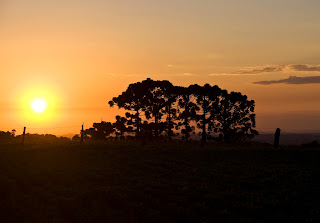 |
| Araucária, AKA Pinheiro-do-Paraná |
One of the most distinctive sights in Paraná is the
araucária, also known as pinheiro-do-Paraná (Paraná pine) or
pinheiro-brasileiro (Brazilian pine).
While it can be found throughout the south of Brazil, it is considered
the state tree of Paraná and can be seen everywhere. While there are several varieties of
araucaria, they all have the same basic shape; tall, with long branches at the
top with leaves forming in round bunches and a flat top – almost as though it
reached a maximum height and then started growing outwards.
 |
| A stand of pinheiros near Pato Branco |
They can be found almost anywhere around here, either
growing together in stands of pinheiros, sometimes rising above the canopy of a
forest, sometimes growing individually and sometimes in the middle of a
city. It is not uncommon to see a
pinheiro or group of the trees in the middle of a big city, such as Curitiba.
The seeds of the araucaria, called pinhão (the plural is pinhões) in
Portuguese and edible and extremely popular in the South of Brazil and among
populations of native Brazilians. Due to
extensive logging and the popularity of the pinhão, the araucaria has become
endangered and the sale of pinhões is only permitted during a specific period
between April and August. Selling
pinhões outside of this period is considered an environmental crime.
 |
| Pinha: where pinhões come from |
People in Paraná go insane for these seeds! During the build-up to the start of the
season (which was 1st April this year) local newspapers publish the
date that the season starts and all over social media people post memes and
countdowns until the start of the season. When the magic day arrives, pinhão
sellers appear by the side of every highway, huge crates of the things appear
in the supermarkets and people rush to buy a bag of pinhões then rush to get
them home and in a pan.
So what’s all the fuss about? With such excitement and expectation before
the season begins, with practically everyone asking whether I’d tried pinhão,
it sounds like it’s Brazil’s answer to truffles. The reality?
Um, it’s ok… I have to admit I
wasn’t overly impressed the first time I tried pinhão.
Before you even get to taste it, you need to get past the
shell, the best approach being to carefully bite one end, squeezing the inner
part out through a split in the front.
But it doesn’t always go according to plan: sometimes the split isn’t
big enough and you have to peel away the shell (not the easiest thing in the world),
sometimes you bite into the seed and need to pick bits apart, sometimes you get
a rotten one and when you bite, you get a mouthful of foul-tasting juice. Oh and don’t burn your fingers on the hot
shell, but don’t wait for it to cool, as it’ll be even harder to extract the
inner seed. So before I’d even got into
the pinhão I was irritated with it!
Well, hopefully it’s worth the effort…
 |
| Inside the pinhão |
As I said, it’s ok, but not amazing. The seed is a few cm long with a firm texture
and an earthy flavour, not quite like anything I’d tried before, improved by
dabbing it in a bit of salt. All I can
assume is that it’s an acquired taste (as you do find yourself working your way
through the bowl at the same pace as anyone else, only slowed down by your
inefficiency at opening the damned things!)
Maybe in a year or so, I’ll be joining in the hysteria when pinhão
season starts again!
There are other ways of eating pinhão, aside from boiling
and squeezing them into your mouth (you can roast them as well but it’s even
more difficult to open them). There are
numerous recipes for meat dishes with pinhão, pizza toppings, pinhão cake,
pinhão pudding… To date, apart from the
aforementioned boiling technique, I’ve only had one dish of meat with pinhão
and it did make for an interesting addition, so let’s see some of these other
recipes.
No comments:
Post a Comment